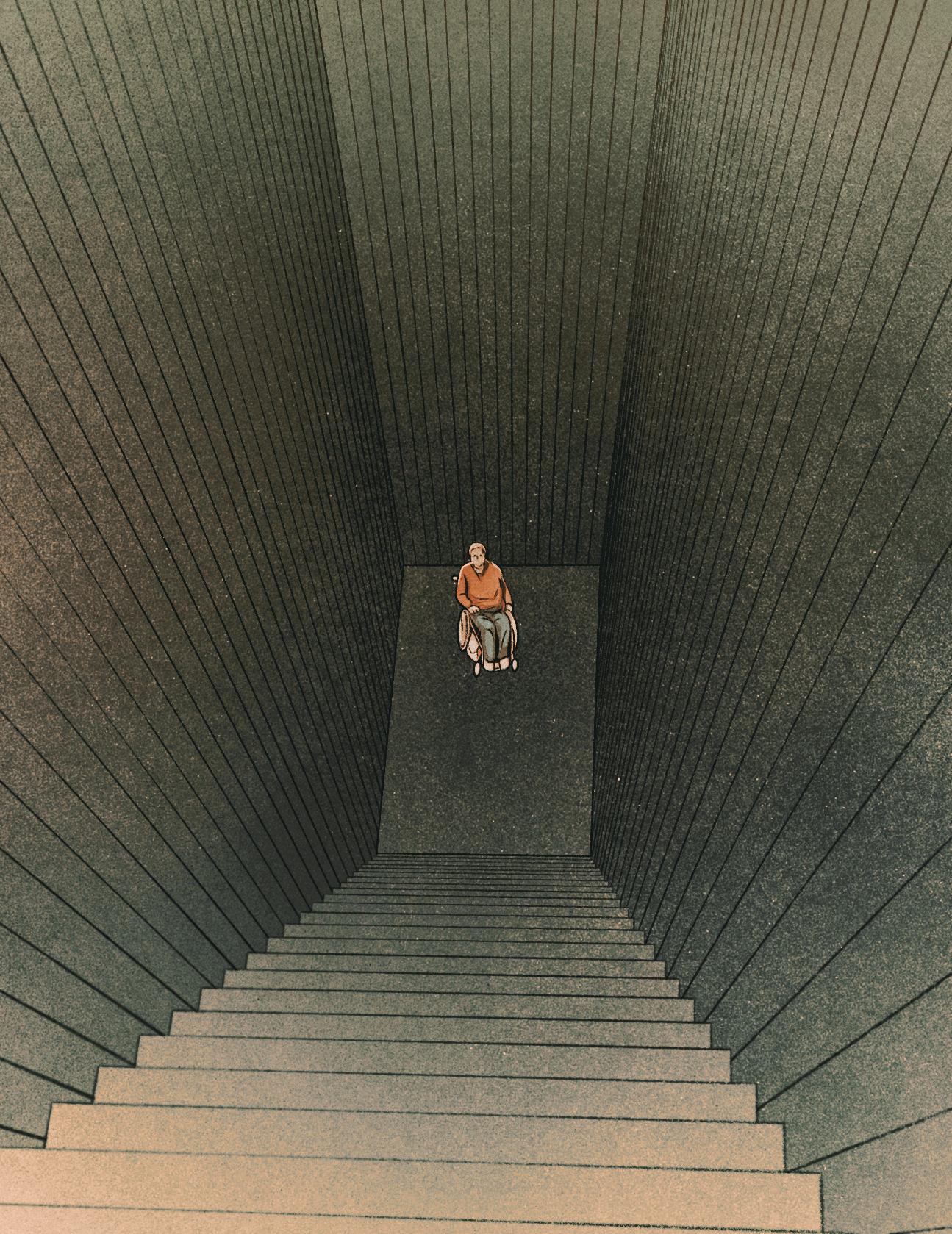Prøve GULL - Gratis
INSULT TO INJURY
Mother Jones
|September/October 2022
Inside the Kafkaesque process for determining who gets federal disability benefits

WHEN ALBERT DIAZ, then 41, took his seat in the Social Security Administration's hearing room in Wilkes-Barre, Pennsylvania, in October 2011, he had to lower himself onto his left buttock to avoid stabbing pain in his right leg. His dominant arm, the right one, was locked in a brace to keep it from curling in toward his body. He shook uncontrollably, a side effect of an electrical stimulation device implanted in his spinal cord to manage relentless pain. Three years earlier, Diaz had fallen backward three stories down an elevator shaft while working as a maintenance director in a luxury apartment building. Since the accident, his family of nine had relied on his wife's teaching salary. His application for federal disability benefits was denied, and after waiting a year for a hearing, he'd come to appeal that decision before an administrative law judge (ALI).
During the half-hour hearing, Diaz told the judge about his pain and how his family has to help him bathe, get dressed, and shave. Following his testimony, a vocational expert spent a few minutes testifying about what someone in Diaz's condition could do for work. The conversation went like this: The judge asked the expert to imagine a hypothetical person of Diaz's age, education, and work experience. Now, the judge said, imagine that this person can do light work, with limitations. "There would be a bilateral lower extremity push/pull limitation," she clarified, "occasional climbing, balancing, and stooping but never on ladders, never kneeling, crouching, or crawling."
The judge then asked the vocational expert whether there were any jobs suited to such a person. Considering only the factors the judge had described, the expert answered that the person could be a "greeter/host," and indicated that there were about 200 or 300 such jobs in northeastern Pennsylvania. Or they could be a "price marker"-who attaches price labels to merchandise-1,100 to 1,200 jobs.
Denne historien er fra September/October 2022-utgaven av Mother Jones.
Abonner på Magzter GOLD for å få tilgang til tusenvis av kuraterte premiumhistorier og over 9000 magasiner og aviser.
Allerede abonnent? Logg på
FLERE HISTORIER FRA Mother Jones

Mother Jones
REFRIGERATOR MOMS REDUX?
Don't blame ADHD on stressed moms.
8 mins
September/October 2025

Mother Jones
NEIGHBORHOOD WATCH
ON THE GROUND WITH A SCRAPPY NETWORK OF VOLUNTEERS PROTECTING THEIR COMMUNITY FROM ICE
8 mins
September/October 2025

Mother Jones
ROOFTOP RESISTANCE
TRUMP IS TRYING TO KILL SOLAR. HERE'S HOW TO FIGHT BACK.
18 mins
September/October 2025

Mother Jones
“DIVISIVE"
How the right enforces the myth of American unity
4 mins
September/October 2025

Mother Jones
PLASTIC MEASURES
The synthetic stuff in our brains, oceans, and politics
3 mins
September/October 2025

Mother Jones
STATUS ANXIETY
HOW TO DEPORT 1 MILLION PEOPLE A YEAR? MAKE RULE-FOLLOWING IMMIGRANTS UNDOCUMENTED.
12 mins
September/October 2025

Mother Jones
HIDING IN LA
WHEN DEPORTATION forces descended on Los Angeles, a new reality set in for many Angelenos: the fear of living in a city under constant threat from ICE. For many, it means sheltering in place—avoiding work, social life, or even a walk outside.
1 min
September/October 2025

Mother Jones
PROJECT 2026 TRUMP'S PLAN TO HIJACK THE NEXT ELECTION
On an April episode of the popular Politics War Room podcast, the veteran journalist Al Hunt posed an increasingly common question from listeners to Democratic strategist James Carville. “Is Trump looking to spark enough protest to justify declaring martial law in 2026, thus suspending the election?” Hunt asked.
18 mins
September/October 2025
Mother Jones
THE POWER OF BILL MOYERS
Remembering a legend—and friend
4 mins
September/October 2025

Mother Jones
THE GOLDEN KINGDOM
Crypto's true believers gather and rejoice under Trump.
10 mins
September/October 2025
Translate
Change font size
